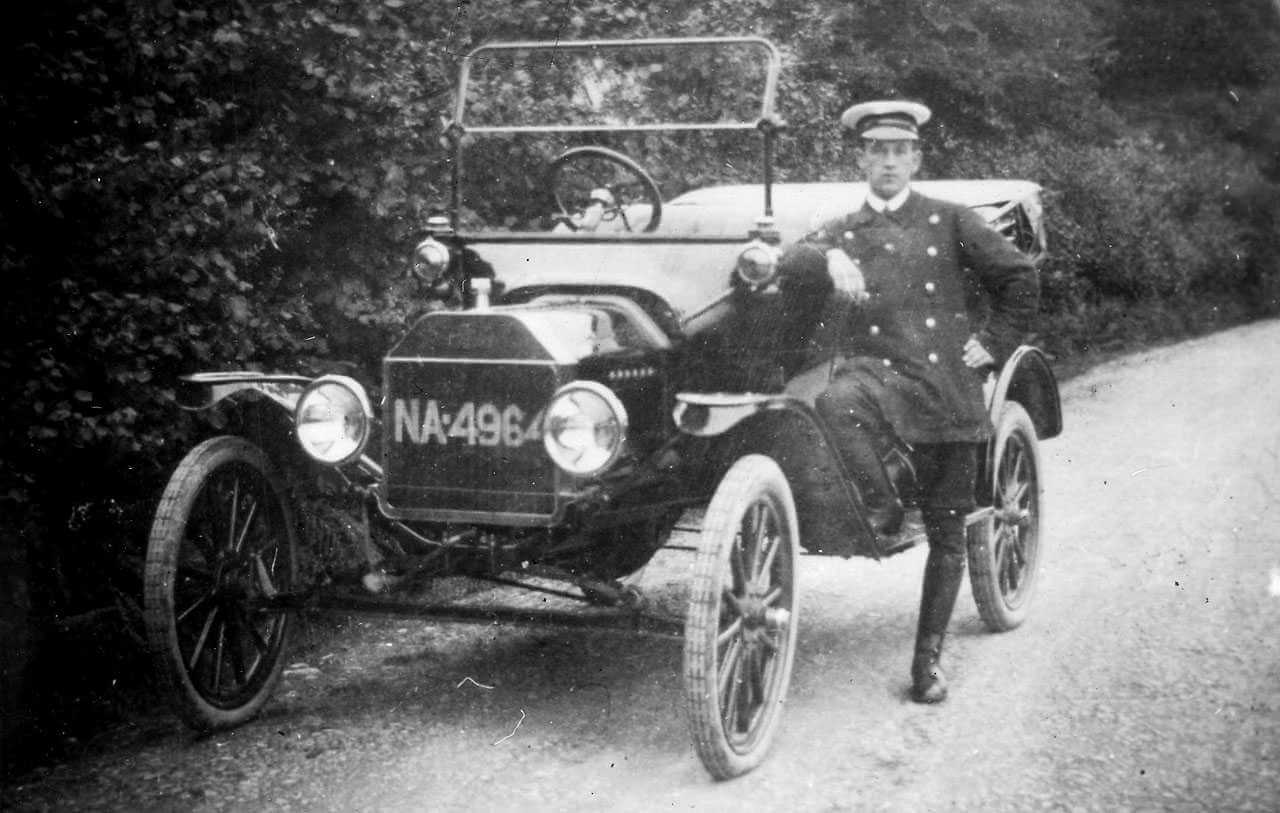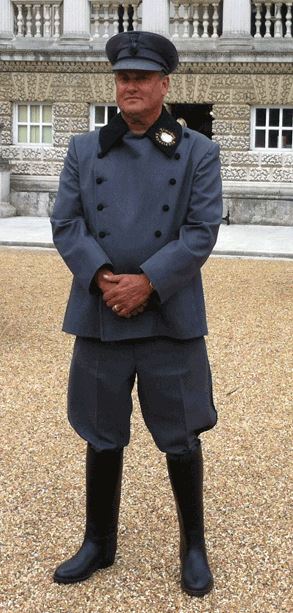With the Pebble Beach Concours D’Elegance, Hot August Nights, Model A Club gatherings, and Cruisin’ the Coast all just around the corner, there’s no better time to talk about car shows — or more specifically, accurate costumes for antique and classic car shows and meets.
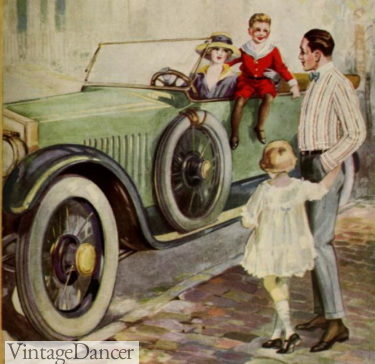
Classic car shows are a pillar of most car clubs and hobbyist communities. There are dozens of opportunities to attend one in any season, and they’re a great way to socialize and find others with your same passion.
For themed nights, car shows, or just for fun, antique and classic car meets are a great opportunity to dress historically to match your vehicle.
Read on for some unique 1920s car show clothing ideas (and a bit of history, too).
This article is dedicated to the most revolutionary decade of the 20th century automobile- the roaring twenties. Read 1900s -1910s Motoring fashion first, then on to the 1920s…and ahead to the 1930s. Many of the 1930s outfits ideas would also work for the late 1920s.
A Short History of 1920s Classic Car Culture
What was New?
The automobile had a massively transformative effect on the American landscape. As car ownership exploded between 1919 and 1929, automotive-related fields grew just as rapidly. Sales, service, manufacturing, fueling, and then new roadside businesses all reaped the benefits. Greater ease of commuting also gave agency to those who lived outside of urban centers, making suburban living the new desired standard.
New to the decade were modern-type gas stations (then called filling stations), convenience stores, motels, service stations, and roadside restaurants.
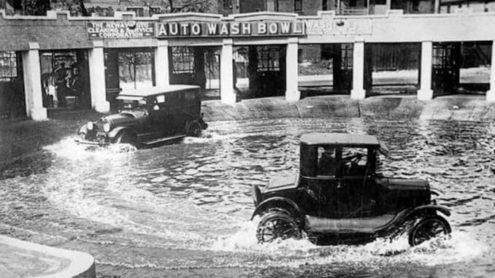
An Auto Wash Bowl – Patented in 1921, it allowed cars to clean mud from their undercarriage. Few roads at the time were paved.
History: Who Owned Cars in the 1920s?
There was a distinction between the early 1920s and late 1920s as far as car ownership went: where the early 1920s had utilitarian cars whose affordability and ease of maintenance was their selling point, the late 1920s saw a growing push towards passenger cars and luxury features.
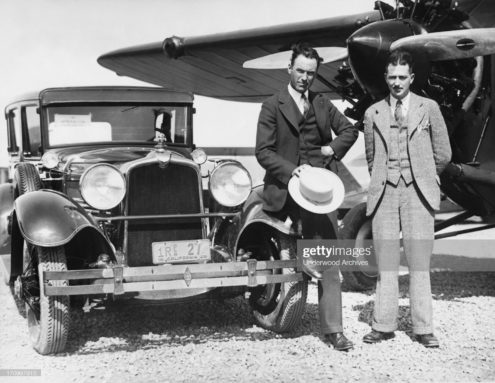
Howard Hughes and stunt flyer Roscoe Turner at an airport in California. Hughes is driving the official car of the Pacific Aero Club. California, 1928. (Photo by Underwood Archives/Getty Images)
Among the earliest adopters of automobiles were police officers and doctors. However, it was farmers who owned one third of all registered cars in the USA, and 75% of all vehicles were kept in towns with populations of less than 50,000.
Common 1920s cars were the Ford Model T, Ford Model A, Packard, Chrysler Six, Nash, Rolls-Royce, and Mercedes-Benz. The rich and famous such as Greta Garbo, Clark Gable, even Al Capone, drove the Duesenberg Model J, a luxury car.
With affordable economy cars and the inception of buying cars on credit, their accessibility made them not only easy to get but oftentimes massively beneficial. This overrepresentation in rural communities would remain in place to the end of the 1920s, but vehicle trends began to change.
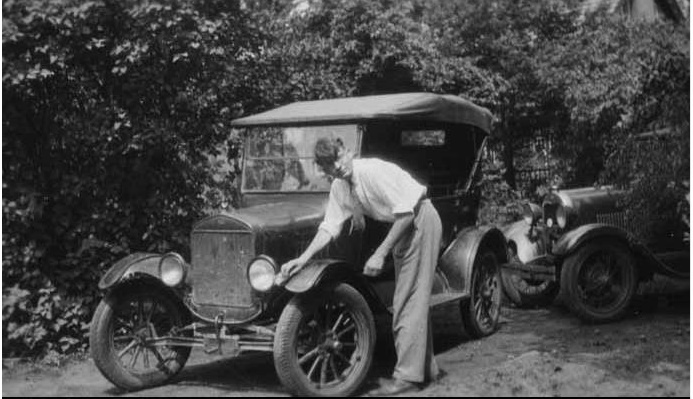
By the late 1920s, many things happened to transform auto purchasing habits and the market as a whole. For one, rapid technological advancement led to the addition of more luxury features in vehicles, like the electric starter.
Larger, more powerful engines allowed for the flourishing of the hard-bodied sedan style, which quickly outsold and overwhelmed the traditional ragtopped roadster model. GM’s “ladder of success” model, providing tiered vehicles for every class and level of luxury, allowed many families to “work up” to a better car or to buy one on credit that they couldn’t otherwise afford.
The progress of fancier vehicles was set in motion, and even the Great Depression would not stop it…
Accurate 1920s Costume Ideas for an Antique Car Show
Bootlegger / Moonshine Runner
Before car races became a major commercial enterprise, moonshine runners “souped up” their simple autos to help them cross land more quickly and evade any police trouble. As cars grew faster, this became an arms race between not only the bootlegger and the law, but among the runners themselves. Tricks were found, shared, and a culture developed that would eventually lead to the inception of NASCAR — making this a great nod to automotive history.
This outfit idea would work best for early 1920s vehicles or the more economical “country cars” of the later years. While big city mobsters likely drove some of the most luxurious cars on the market, bootleggers were stuck with far humbler autos, either by necessity or so as to arouse less suspicion.
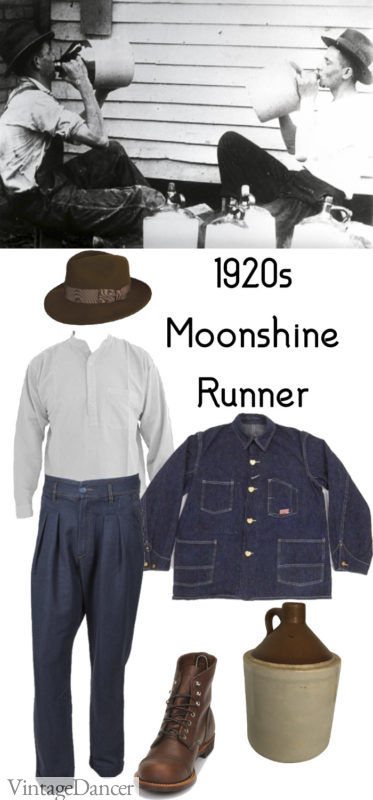
How To: A bootlegger would not be wealthy. He would wear work clothes in durable fabrics. Start with a simple work-shirt and loose, high waisted pants or overalls. Top with a chore coat and some brown or black boots. You can accessorize with a hat, suspenders, and a prop moonshine jug or gun.
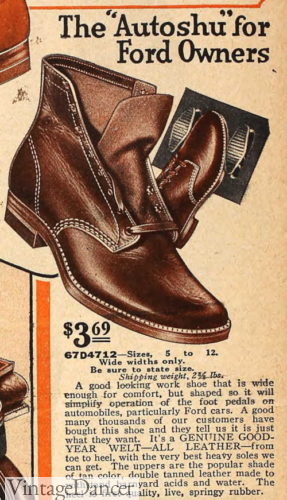
1925 Autoshu for Ford owners – Wide fit word boot with a shaped toe to fit on the pedals
Want similar costume ideas? Read our 1920s men’s workwear article for more example pictures and outfits that would work.
For more traditional gangster/mobster clothing, click here.
Filling Station Attendant
In the 1920s, drivers transitioned from purchasing gas over the counter or from the local smithy to purchasing it at a filling station — what we’d call a gas station today. Uniforms seemed to prefer white or light colors in either separates or coveralls.
A work badge or name tag is optional — there were countless local filling stations as well as the beginnings of a few chains, with Texaco being the first to have a hand in all 48 states. You can either design your own uniform logo and nametag for your car, or you can look here for a few major names.
All internal combustion vehicles need gas, making this costume great for vehicles of any type.
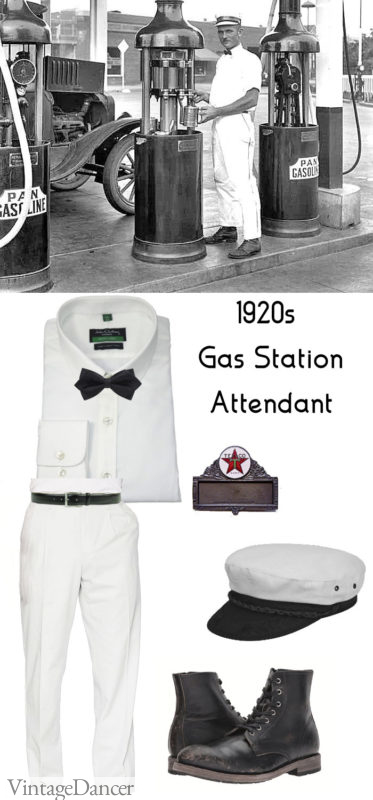
How To: Begin with a white short- or long-sleeved shirt and either white or brown/tan pants. Add a belt, bowtie, cap, and brown or black boots. Grease stains and a 1920s hair style are optional. While real gas station attendant name badges from the 1920s are quite expensive, it is easy to find or make substitutes.
Women were also gas station workers in the 1920s. It can make for a great couple’s car show costume. You can also match with her as the service station’s mechanic by wearing blue coveralls.
Mechanic
Auto shop mechanics often wore blue or grey coveralls, overalls with a work shirt, or work pants with a belt and a work shirt. More about men’s 1920s work clothes and where to buy them.
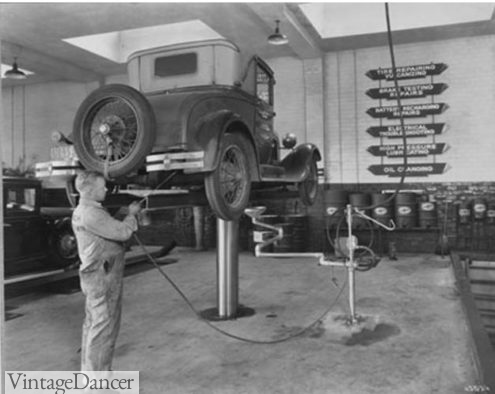
1920s Mechanic Shop – Wearing Coveralls
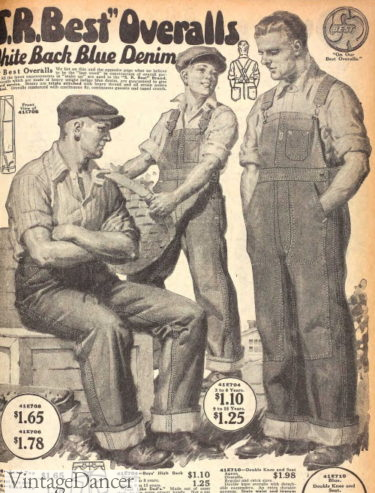
1921 Denim Jeans and Overalls
1920s Chauffeurs and Taxi Drivers
1920s chauffeurs are a popular costume idea, especially for weddings and 1920s auto club car shows. The chauffeur uniform was largely unchanged between the 1910s and 1930s and we will go more in depth on it in the 1930s article.
FormalTailor (UK) offers Chauffer uniforms and caps. Also ask uniformsbypark (USA) if they can make one.
- Chauffeur and Car, 1920s
- Man in 1920s Chauffeur Uniform from Timeless Weddings
Not all hired drivers dressed in specialty uniforms. Most taxi drivers and private cards were driven by men in regular suits with a driving cap or yacht style cap.
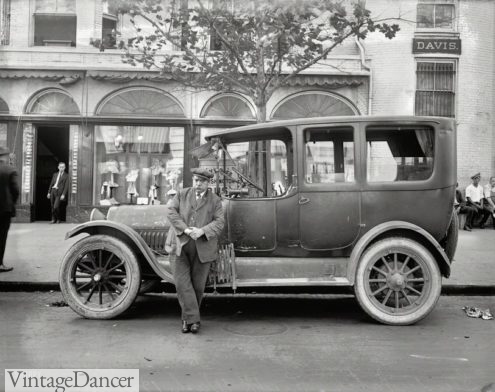
W.V. Wolfe of the Frederick and Washington Bus Line 1921 studebacker hired car
Owners: Casual Sportster
Cars led to a revolution in suburban living, while also making the commute from the city to the local country club far easier. With the extra accessibility and time, many more people were able to pursue rural leisure activities, like golfing. Though once considered a rich man’s sport, the comfortable middle classes began to involve themselves in the weekend golfing scene as well.
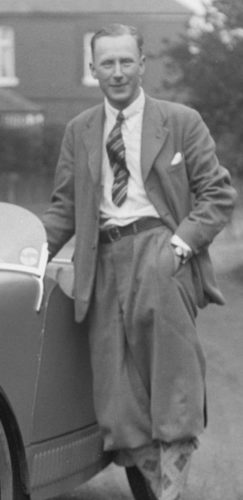
MG M-Type of C Robinson, c1929. Artist: Bill Brunell. MG M 847 cc. Vehicle Reg. No. MG1930. Driver: Robinson, C. Early M type with rear-hinged doors and original brake layout. Date: c.1929. (Photo by National Motor Museum/Heritage Images/Getty Images)
Thanks to the explosion in casual fashion led by popular figures like the Prince of Wales, the golfer outfit is iconic and easily recognizable. Besides golf, the outfit was worn for any casual “outing,” sport, or country drive.
Quintessentially 1920s, the golfer outfit is a great option for any mid- or high-end vehicle, like some 1920s Nash or Packard models. 1920s Rolls Royce models and other luxury imports work just as well.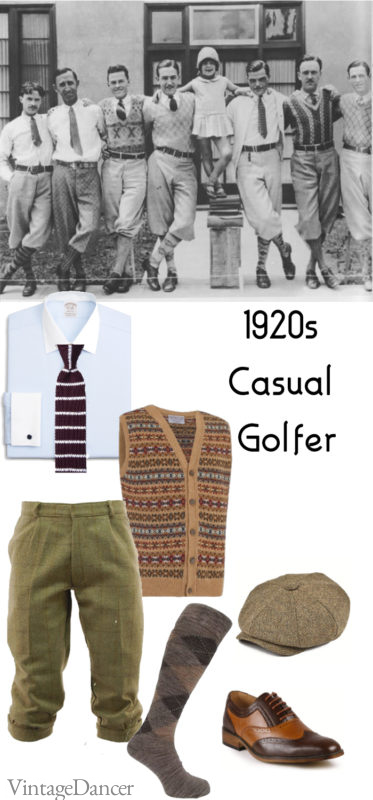
How To: Start with a simple solid colored button up, a pair of plus fours (knickers), and patterned high socks. Wear Oxford shoes in solid brown or a sporty two-tone (white and brown). Finish with a belt and tie, or add a knit vest, cap, and/or suit jacket. The 1920s were obnoxious, so don’t be afraid of clashing colors and patterns. If possible, consider putting a golf bag in your car to tie your costume to your vehicle.
You may also like The Great Gatsby-style white suit outfit.
Owner: Farmer
Suits and hats were the uniform for men of the 1920s. While the suit silhouette changed dramatically throughout the decade, the key elements of the suit remained largely the same — even today. As an homage to the farmers who owned the majority of 1920s autos, we’ll focus on the less formal sack suit of the early 20th century. They are comfortable and loose, perfect for a day spent out running errands.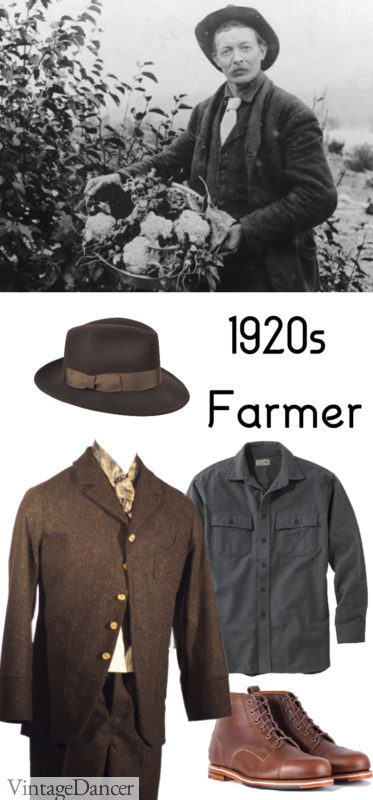
How To: This is a very simple costume. Start with a lightly patterned or textured three piece suit in either a vintage cut or 1-2 sizes up. A two or three button jacket is ideal. I am very fond of this one, but there are many options here and here. Hem pants to mid ankle and wear with a simple shirt and tie.
Suit separates in a similar but not matching color can also be worn. Finish with a Homburg hat or cap and some boots. If desired, top with a trench or duster coat to keep the elements at bay.
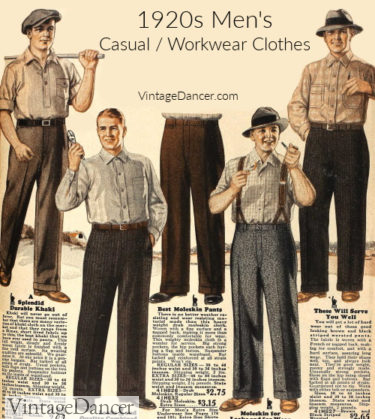
1927 men’s workwear
Daredevil Driver
Men who had a need for speed had different clothing requirements. Motorcycles riders, aviators (pilots)and open car race car drivers often dressed in leather from head to toe. Such as the outfit below: Leather newsboy cap lined in silk, googles, leather coat, leather breeches, leather puttees (leg covers) and boots. Under the jacket should have been a basic dress shirt and tie.
Leather was the best at wind and accident protection although hot and not very flexible.
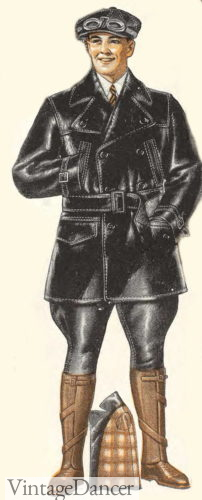
1929 men’s all leather jacket and breeches outfit
Corduroy was a more flexible fabric outfit of the same design. There were also heavy cotton twill and suede fabrics for lower cost.
A leather aviator cap with chin strap was a good choice for fast drivers too.
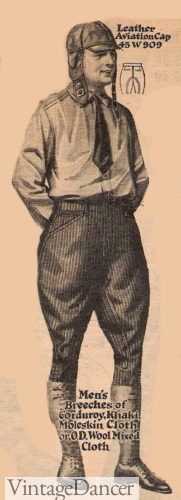
1923 corduroy breeches
Heavy wool was a third dressier option for professional occupations.
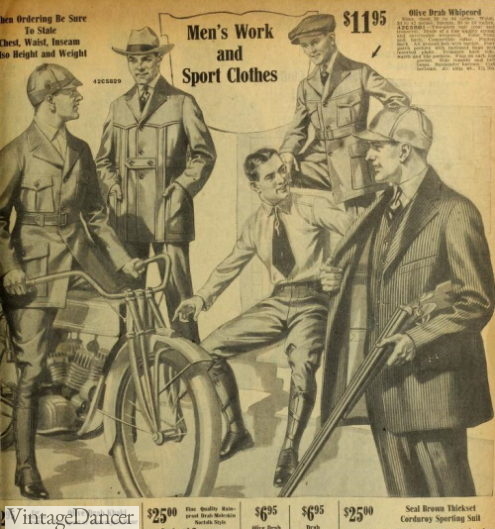
1920 corduroy breeches
Schott nyc – Large selection of leather jackets, workwear, boots and some knitwear. Very high quality.
The Future?
The stock market crashed in 1929. With the Great Depression lasting through most of the 1930s, many were left using older cars that they already owned or could afford. While many early-mid 1920s cars were severely underpowered, necessity kept them in use.
Lastly, flashy hot rods built from 1920s cars were rarely products of the 1920s. Most traditional hot rods were built in the late 1940s and 1950s from cheaply available cars of the 1920s and 1930s. High-powered racers of the 1920s, generally called speedsters, were less stylized and functioned primarily in race car circles.
For more articles on 1930s, 1940s, and 1950s car show outfits for men.
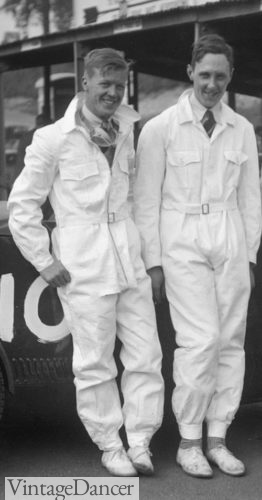
1930 Racing drivers with a Lea-Francis 1496 cc at Brooklands. Lea Francis 1496S cc. Event Entry No: 10. Place: Brooklands. Artist Bill Brunell. (Photo by National Motor Museum/Heritage Images/Getty Images)
More Accurate 1920s Men’s Clothing Ideas
The beginning and the end of the 1920s looked very different in just about every walk of life, and apparel is no different. To find 1920s clothing accurate to the specific year of your car, click here for an in-depth overview of 1920s men’s fashion history with picture examples.
For additional 1920s themed men’s outfit ideas:
- 1920s Men’s Outfit Inspiration & Costume Ideas
- 10 Easy 1920s Men’s Costumes Ideas / Outfits
- 1920s Men’s Workwear, Casual Clothes
- 1920s Men’s Vintage Casual Outfit Ideas
- Men’s Vintage Boating Outfits, Sailing Clothes
- 1920s Tennis Clothes | Women’s and Men’s Outfits
- Men’s 1920s Camping, Hiking, Hunting Clothes (also worn for motorbiking and racing cars)
Where to Buy 1920s clothing
Visit our shop page for a curated collection of 1920s style clothing, from suits to shoes to separates and hats at affordable prices.
Or visit this list of men’s 1920s reproduction clothing for more accurate options.
- Leather cap and silk scarf at Snoopys
- Quality leather flights jackets G-21 or A-2 at Schott NYC
- Historic Racewear – Vintage and new auto racing suits and boots and shoes in the UK
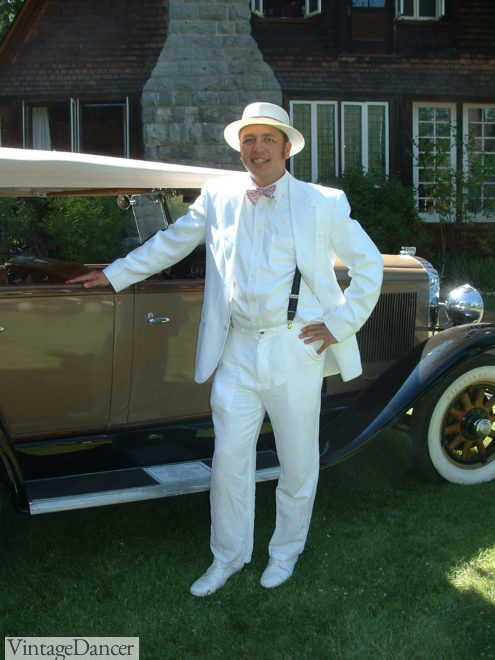
Oscar’s all White Gatsby Summer Outfit
